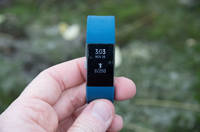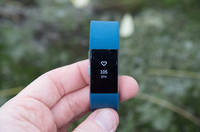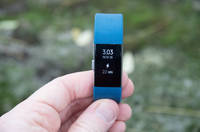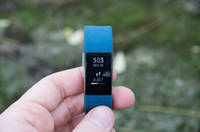Fitbit Charge 2 Activity Tracker In-Depth Review
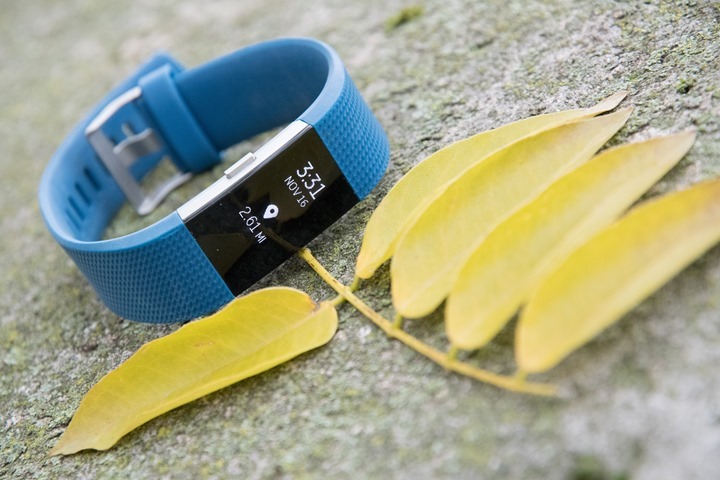
It’s been a bit over two months since Fitbit announced their latest wearables, the Fitbit Charge 2 and the Fitbit Flex 2 (they also announced some Blaze updates and Alta bands at that time). This review however is purely focused on the Fitbit Charge 2, which is the successor for the original Fitbit Charge HR. The name got a switcheroo, since the Fitbit Charge 2 now incorporates optical HR, whereas the original Fitbit Charge did not (but the Charge HR did). Got all that? Good.
I’ve been wearing the Fitbit Charge 2 for a bit over a month now, comparing it day by day to other watches and wearables. Within this review I’ll dive into everything you’d ever want to know about it, from the device usability, to the accuracy, to that of the platform and mobile app. I’ve got it all!
Fitbit sent me a trial unit of both the Charge 2 and the Flex 2, which as usual I’ll return to them upon completion of this review. I’ll then go out and get my own through regular retail channels like normal. If you found the review useful, you can hit up the support links at the end of the post.
With that – let’s begin!
Unboxing:
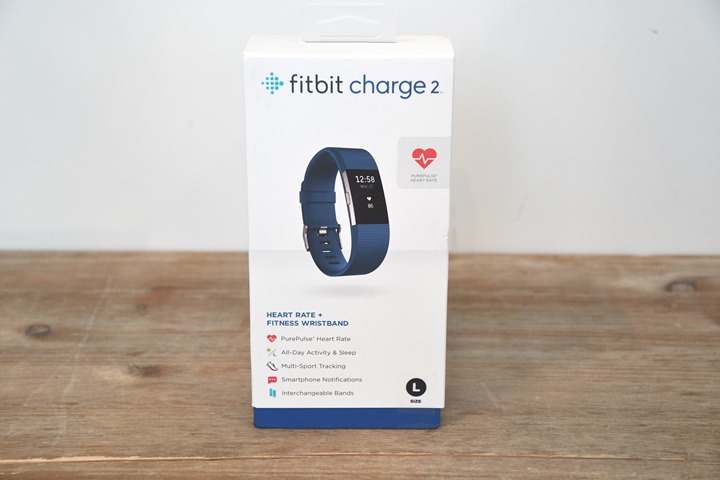
The Fitbit Charge 2 comes in a relatively small box, with relatively few components inside of it. I’m all about minimalist unboxings.
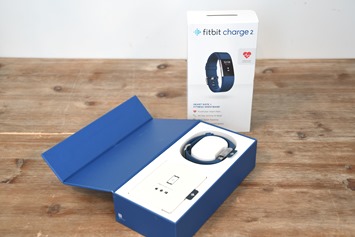
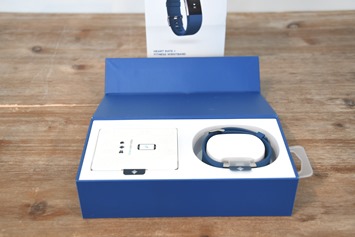
Here we’ve got on the left the USB charger, two pieces of paper, and on the right the Fitbit Charge 2 itself. Like I said – simple.
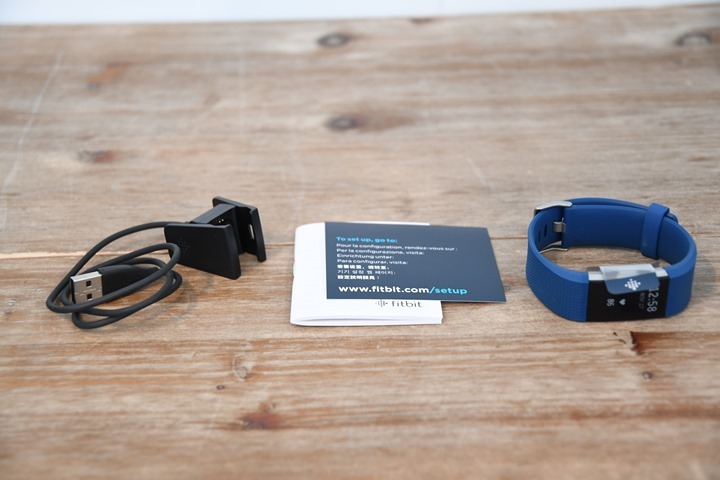
The quick start guide paper tells you to head to Fitbit’s site to get setup, while the thicker white manual gives you a bunch of boring safety and warranty information. Essentially, if you develop a rash and your wrist falls off – it’s your fault.
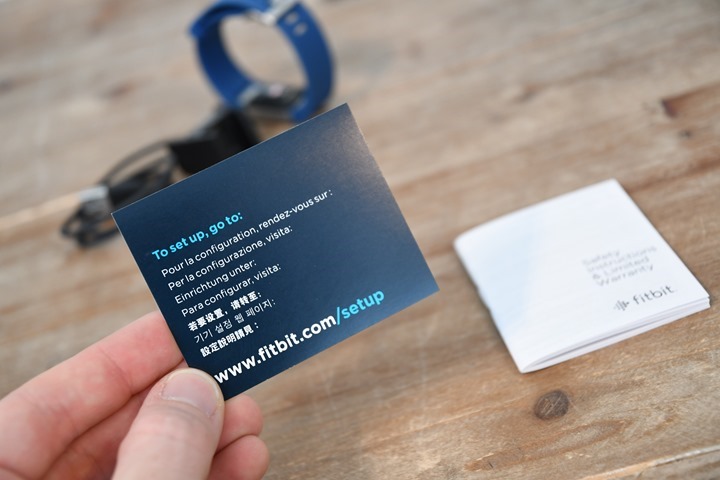
Meanwhile, here’s the unit itself:
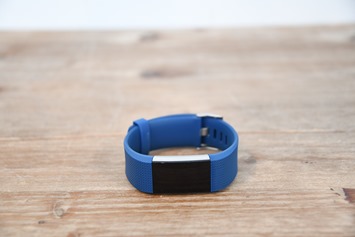
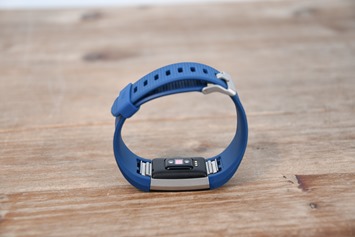
The charging clip simply snaps onto the bottom of it. It’s pretty secure, so there’s no issue with it falling off like some of the older Fitbit wearables charging clips.
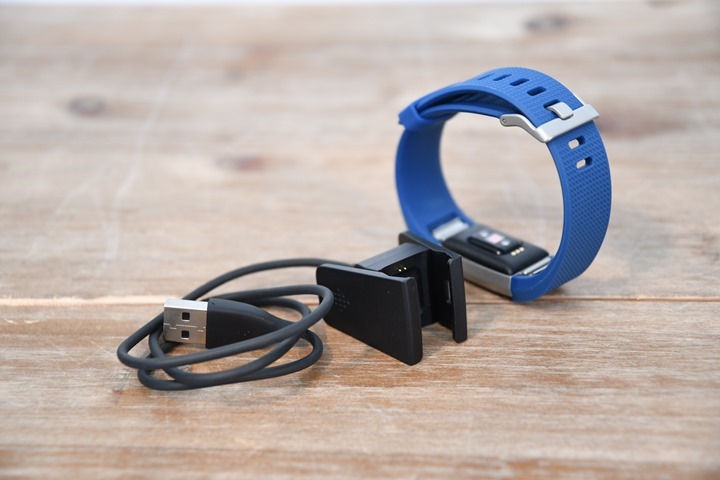
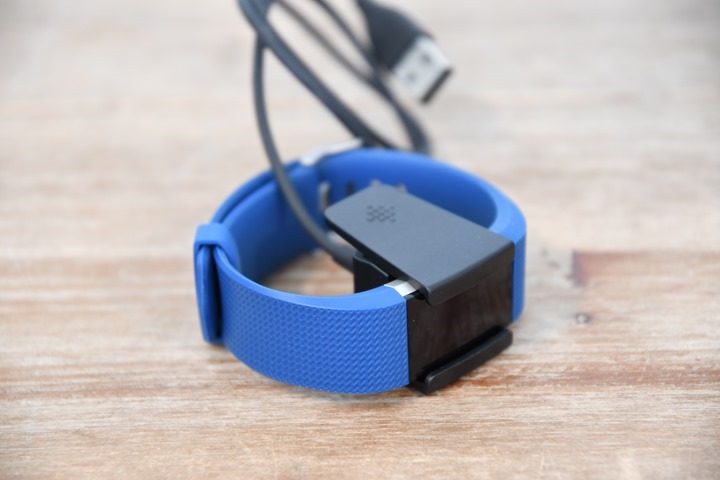
Note that the band on the Fitbit Charge 2 is swappable. You can see how you press these little snaps on either end of the pod, and it’ll pop out of the strap.
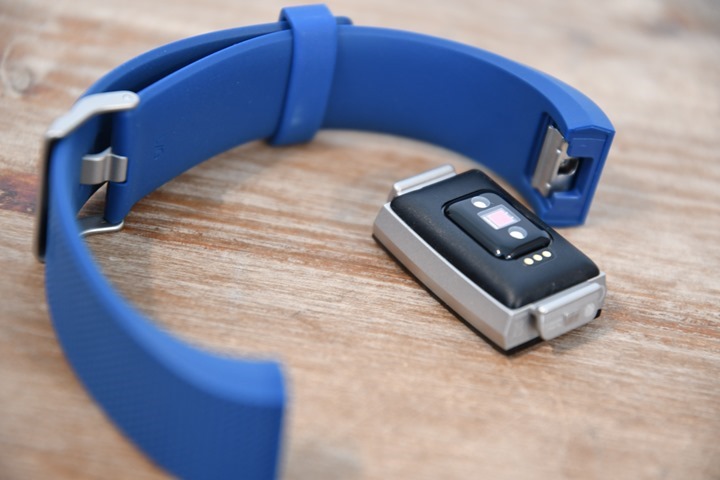
Fitbit then makes other colored straps, like these bits of Skittles awesomeness:
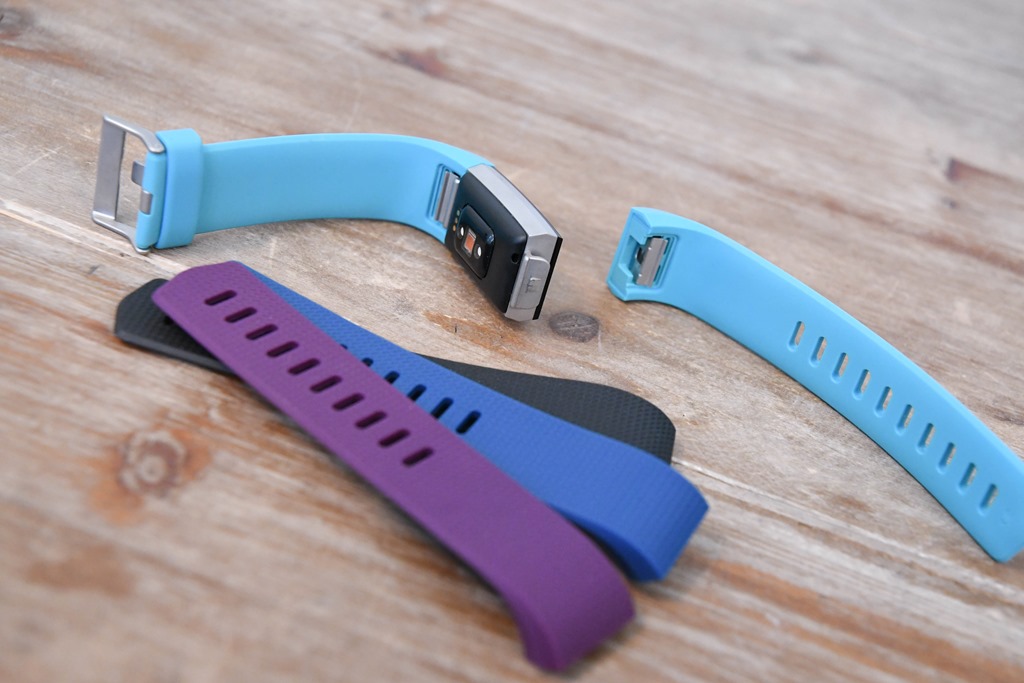
Finally, if you check out the weight of the unit, it comes in at 35g:
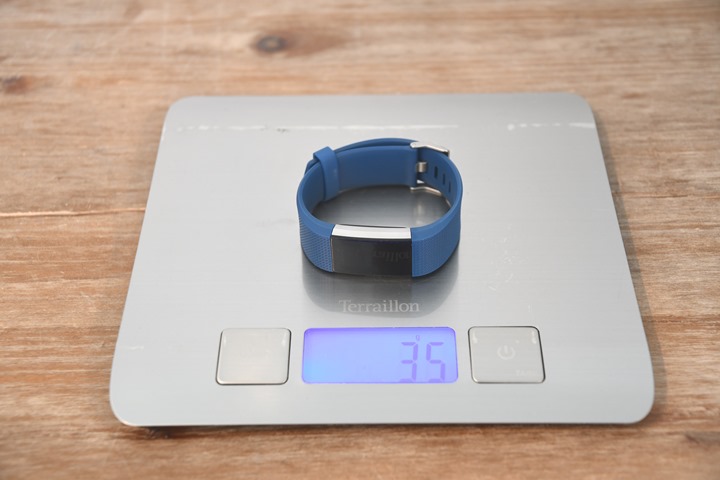
Meanwhile, here’s a few comparisons. We’ve got the Garmin Vivosmart HR (sans-GPS), which is at 30g, and the Polar A360 (sans-GPS) at 37g.


Ok, with that, let’s start using it.
The Basics:
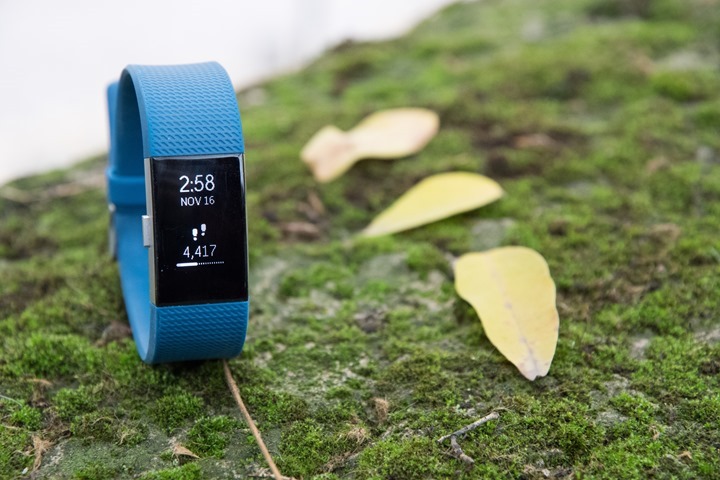
The Charge 2 is in most ways like existing Fitbit wearables, except with slightly more options and features. To begin after setup, you’ll iterate through the menus by either tapping the screen or pressing the side button. However, the unit also supports raising your wrist to see the stats:
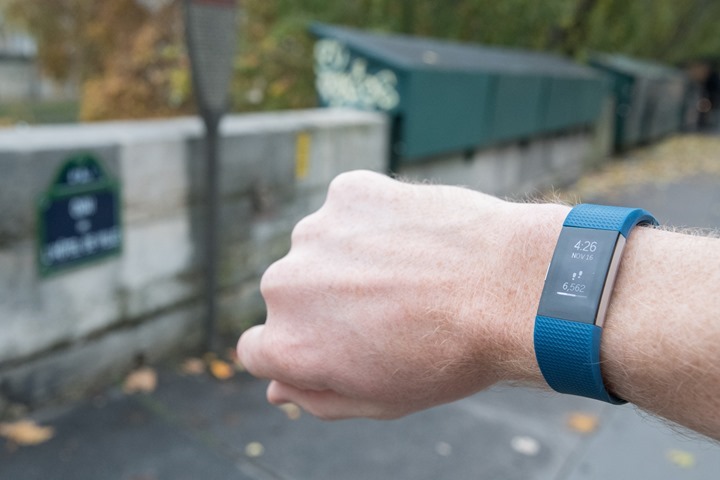
When you do so it’ll show you the last stat you’ve configured. In my case that’s the time, date and steps. However, you can then tap the display to change it to any other given metric. These metrics include: Current HR, Distance, Calories, Flights of Stairs, Active Time, Steps toward hourly goal, Daily Total Steps. Here’s some of those:
Meanwhile, you can then press the side button to change into different modes. These modes include just showing your HR, sport modes, stopwatch, and breathing sessions. For example, once you’ve selected the sport modes, you can then iterate through the different sport modes by tapping. This would then (by default) show Running, Weights, Treadmill, Bike, Workout, Elliptical, and Interval Workout.
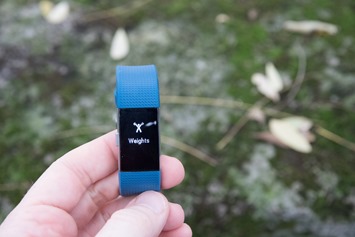
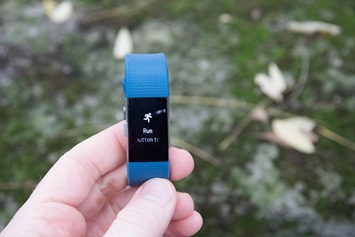
I’ll cover other workout modes in the next section – so hang tight a moment.
So how does accuracy rank? I’ve been wearing the Fitbit Charge 2 and Garmin Forerunner 35, one on each wrist, 24×7 for the last month. Here’s a random 5+ days worth of data (in between charges) from steps and how they shake up:
Nov 16th:
Fitbit Charge 2: 11,271
Garmin FR35: 8,403
iPhone: 9,521Nov 15th:
Fitbit Charge 2: 7,699
Garmin FR35: 6,593
iPhone: 4,170Nov 14th:
Fitbit Charge 2: 8,031
Garmin FR35: 6,327
iPhone: 3,377Nov 13th:
Fitbit Charge 2: 11,849
Garmin FR35: 10,719
iPhone: 6,719Nov 12th:
Fitbit Charge 2: 6,688
Garmin FR35: 3,464
iPhone: 4,355Nov 11th:
Fitbit Charge 2: 12,260
Garmin FR35: 8,365
iPhone: 8,331
I don’t have a very clear idea of which one is right of course, since there’s no easy way to track that across an entire day. Additionally, the different placement aspects would impact things (left wrist vs right wrist vs phone in pocket). I saw nuances in how sometimes one device would pickup more artificial steps than another (such as when swaying a baby to sleep), yet at other times another would be more tripped up by a bike ride.
As I’ve noted many times before, it’s generally better to treat these values as a yardstick and for trending. Don’t fret if you’re trying to hit 10,000 steps and you get only to 9,900. Just go walk the other 100 steps. It won’t kill you. Meanwhile, on the day you walked only 2,000 steps – yes, you were likely lazy. That’s OK – just accept it. Most of the times (like you see above), they tend to trend the same. So largely speaking the Fitbit Charge 2 tended to trend highest of the three.
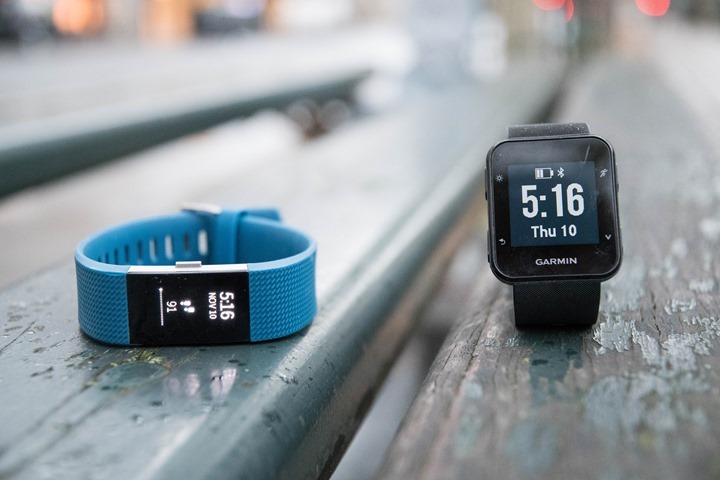
As you might have noticed, I actually get slightly better battery life than they claim – just shy of 8 complete days between charges. Not too shabby since they only claim 5 days.
Next is that throughout the day you’ll be reminded to keep on walking. Fitbit sets a non-configurable goal of 250 steps per hour. While visiting family a few weeks ago, my cousin asked why Fitbit doesn’t allow you to change that warning level, since in reality – 250 steps per hour will still leave you far short of your normal/default 10,000 step goal. It’s a valid question, since you can change the default daily total, just not the hourly chime.
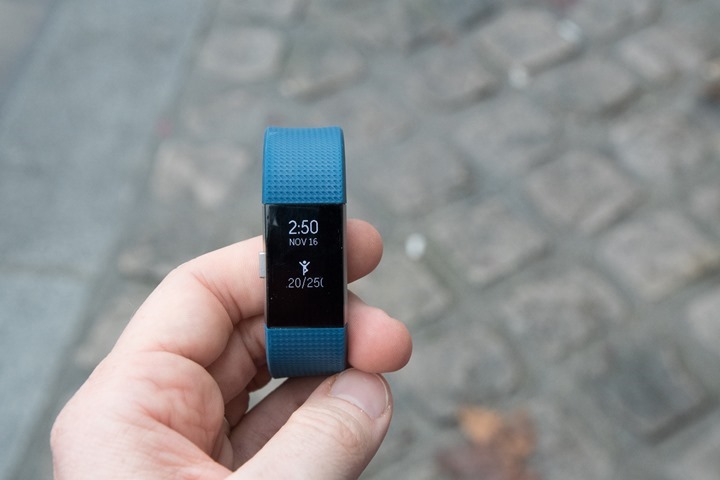
That hourly chime by the way, will remind you at 10 minutes to the hour. So each hour at 5:50PM, 3:50PM, etc… You can specify the range of hours that it buzzes at you, so it won’t be poking you at 3:50AM.
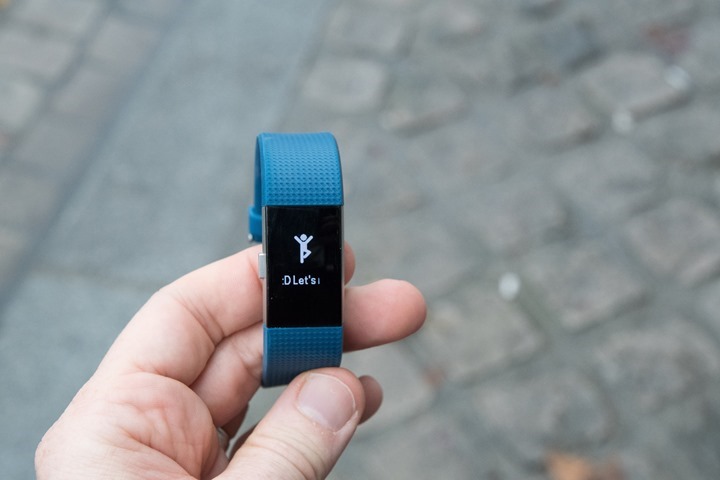
Speaking of buzzes, the unit will display some smartphone notifications. Specifically, it’ll display text messages, call notifications, and calendar alerts. It shows up like this:
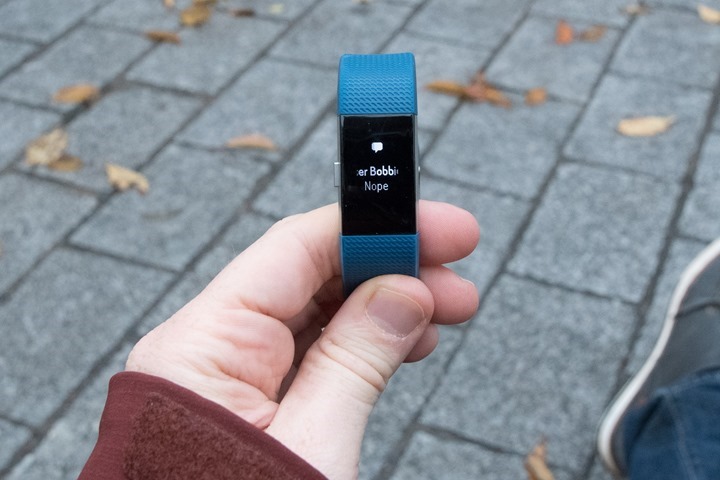
It’s long been a bone of contention that Fitbit still doesn’t display regular smartphone notifications from other apps, such as WhatsApp, Twitter, and Snapchat. Only the Fitbit Blaze gets those. Whereas virtually every other activity tracker on the market receives anything you’ve configured on your phone. In a world where more and more people are depending on 3rd party apps like Facebook Messenger and others for communication, it’s backasswards that Fitbit still tries to hold the line to legacy call and text only. And yes, I’m going to keep banging this drum until they change it (it’s the same drum that every other major review has banged as well).
You can configure notification options through the app:
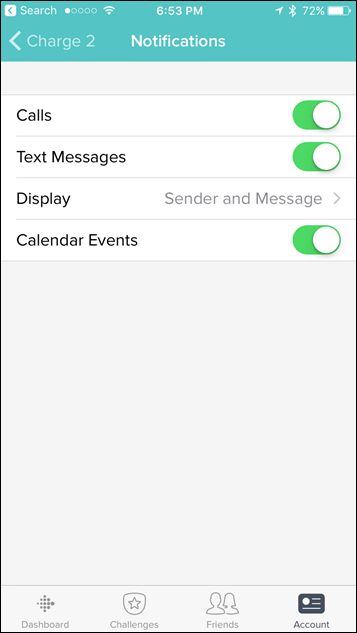
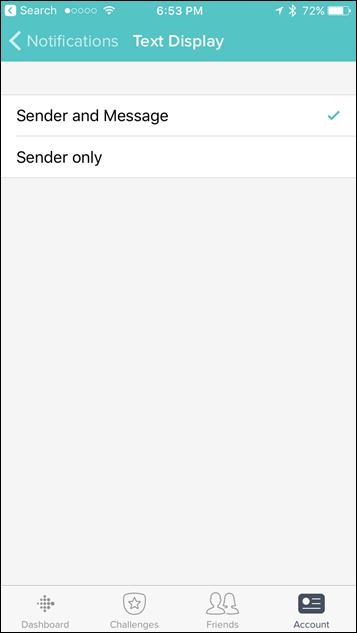
Along the alertation front, you’ve also got the ability to create silent alarms, which can be helpful if you’re sharing the bed with someone else not waking up at the same time.
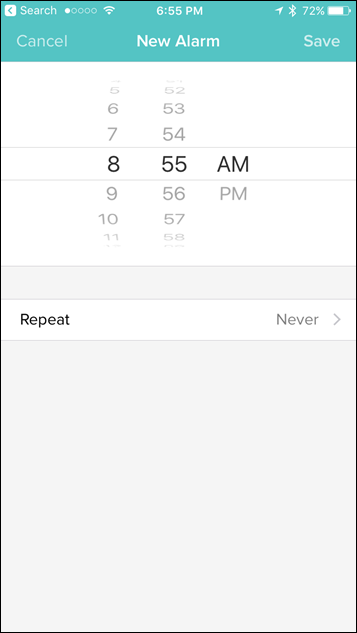
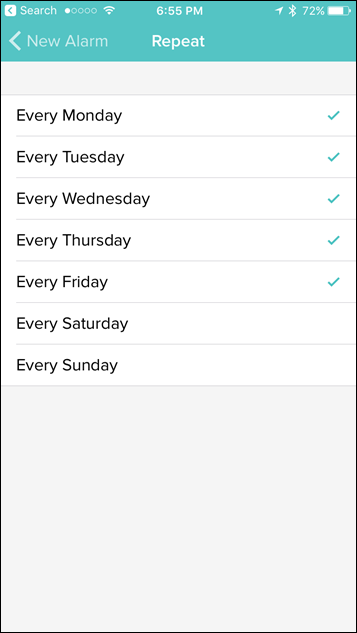
Now’s a good time to point out that the unit can’t make any beeps. Only vibrations. To be fair, that’s somewhat common on wearables, where space/cost/battery life is saved by skipping that.
In my case, I used Fitbit’s ‘All Day Sync’ option, which keeps the wearable constantly sync’d to the mobile app (steps/distance/activities/etc…). In fact, you can even display your current HR on the mobile app – a feature that virtually no other wearable supports. You’ll see that on the below screen, directly under the heart icon.
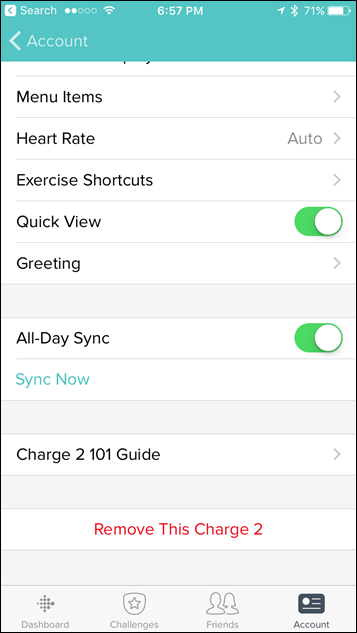
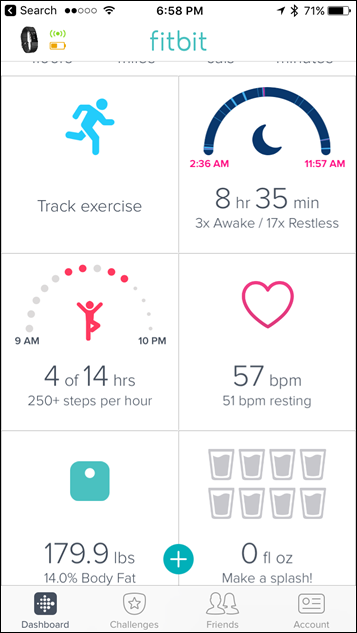
Finally, let’s talk about the breathing exercises, which is designed to promote relaxation. It’ll walk you through a few minute breathing exercise. It’ll guide you to take deep breaths in and out slowly, which it’ll then plot on a little wavelength chart.
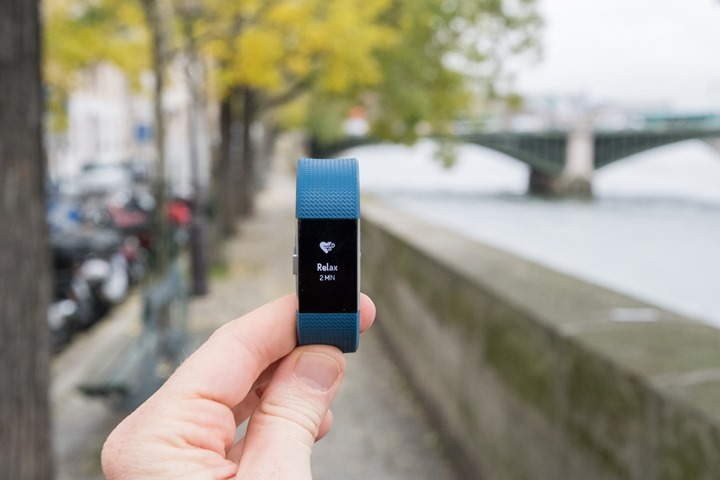
While this did relax me slightly, I wouldn’t necessarily say that the recorded/displayed data matched that of my breathing rate. I could take deep breaths and it’d largely flat-line, while shallow breaths did the opposite. And then sometimes that was swapped.
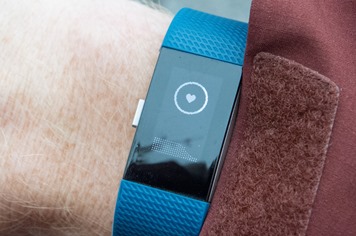
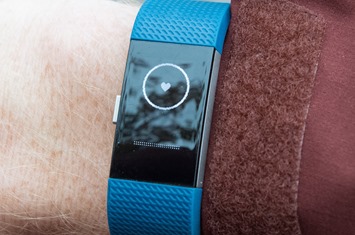
With some relaxation out of the way, it’s off to workout we go. No better way to get the heart rate up. Well, actually, I can think of better ways. But the Fitbit doesn’t seem to have a workout category for that.
Workout Modes:
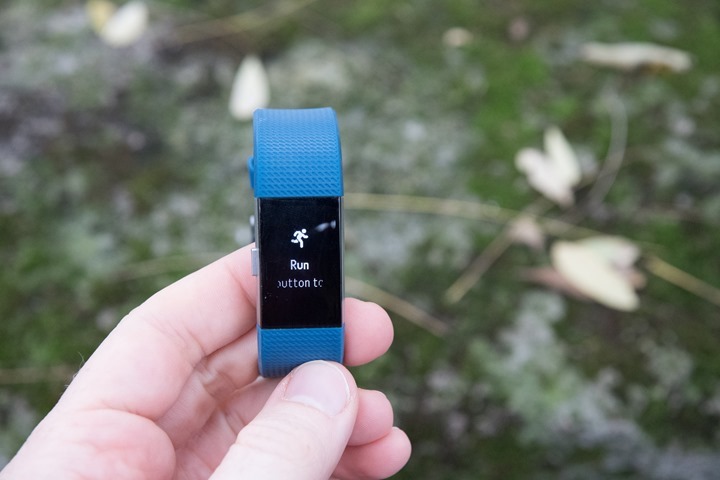
One of the key changes to the Charge 2 is the ability to have unique workout modes. Previously in the original Charge HR you just had ‘a workout mode’, but not ‘modes’. Meaning, it was all or nothing. Now, you’ve got specific modes for different types of workouts. If you run, it’ll categorize it as running. Same goes for cycling, and so-on. Further, by doing this it can leverage Connected GPS capabilities (aka your phone) to provide GPS tracks for outdoor workouts.
To start a workout, you’ll press the side button until you see the workout modes listed. By default the first one is running. But you can change both the order and listing of workout types.
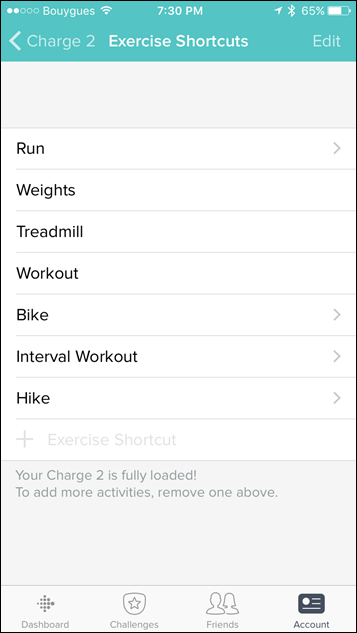
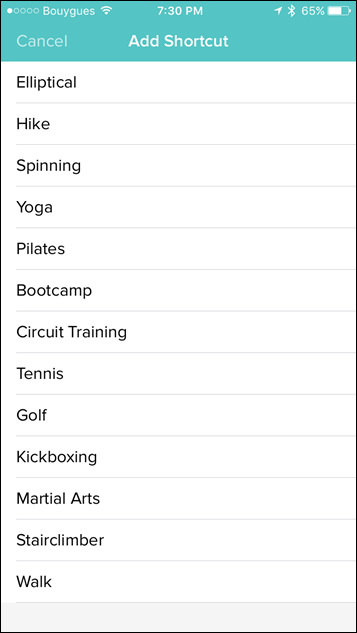
The unit supports the following workout types: Run, Weights, Treadmill, Workout, Bike, Interval Workout, Elliptical, Hike, Spinning, Yoga, Pilates, Bootcamp, Circuit Training, Tennis, Golf, Kickboxing, Martial Arts, Stairclimber, and Walk.
All of these can be configured within the app. And as mentioned earlier some workout types (like ‘Run’) support the ability to use what Fitbit calls ‘Connected GPS’, which means it’ll use your phone for GPS. That’s because the Charge 2 doesn’t have a GPS chipset within it. So it’ll connect to the Fitbit app (which has to be open) on your phone and then record distance and a map using that.
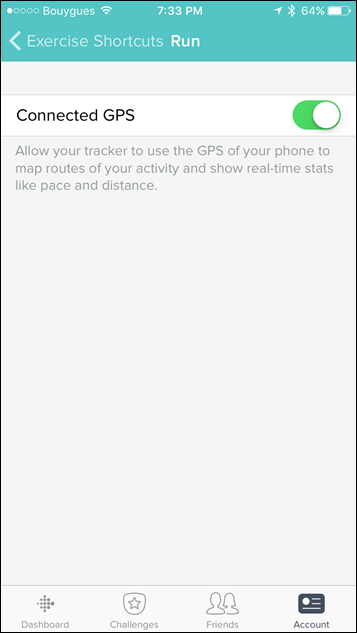
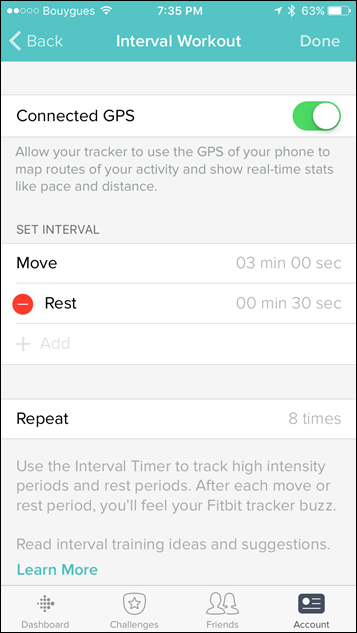
While other workout modes, such as the Interval Workout option, allow you to setup intervals as seen above. This will iterate through each of the intervals, giving you short guidance on the unit itself and counting down time remaining for each portion and the total workout.
However, it’s super-limited. For example, you can’t specify a warm-up or cool-down. And even though you’d think from the above screenshots that you’d be able to create additional entries in that list, you’re limited to a whopping two entries, just the ones seen. In fact, I’m really not sure why they even have the ‘Add’ button, since you can only have one move, and one rest. Shrug.
In any event, once you’ve selected the workout type on the wrist, you can hold down the left button to start the recording/timer. The one downside here is that you won’t really know if it’s successfully connected to your phone for ‘Connected GPS’ until after you’ve held down this button. It’s at that point that it either gives you a happy dance, or a SOL dance. If it gives you the SOL dance, then you’ve gotta kill the workout, troubleshoot the phone connection, and do over.
Once in workout mode, you can tap the screen to change the various metrics displayed.
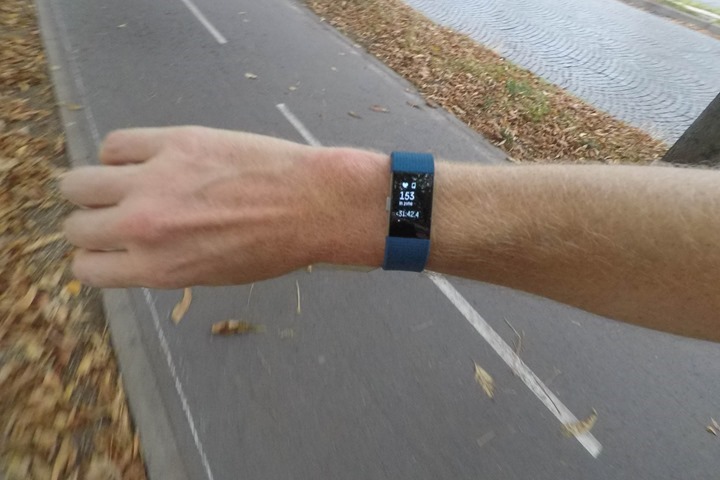
It’s all pretty straightforward, as well as non-changeable. I’ll discuss the heart rate accuracy piece in the next section. Note that if you’re using Connected GPS for outside GPS tracking, then you’ll get a nifty map of where you’ve been afterwards:

Well, most of the time anyway. I’ve had a few cases where it just simply craps out mid-way through the bike or run, for no apparent reason – like below. This is actually a 48.79mi ride (not 15.62mi) that started/ended in roughly the same spot. GPS stopped mid-way, yet it continued to track time. Though, it totally hosed up the HR and related metrics, which are truncated to the abbreviated distance.
(Note: Fitbit is looking into what might be occurring on this and other activities I saw similar or troublesome ‘Connected GPS’ behavior. I’ll circle back once I hear back with the results of their investigation.)
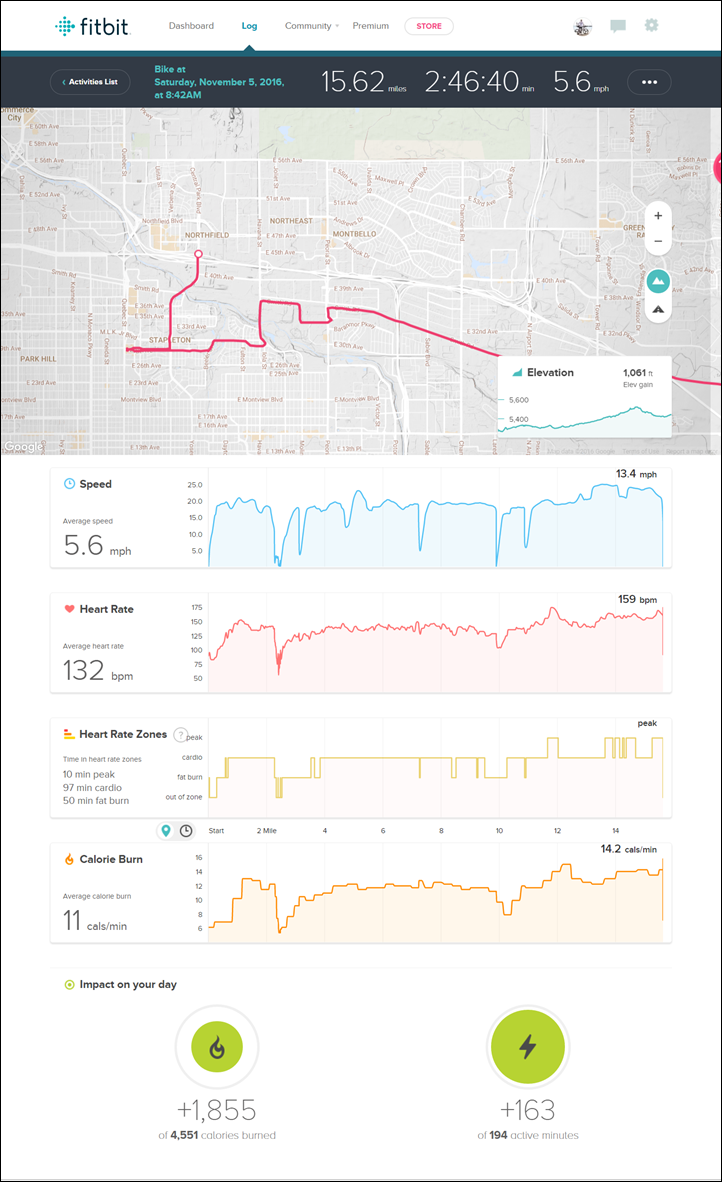
Once your workout is complete you can look at the stats on the Charge 2 itself, or afterwards on the app and/or site. Here’s how it’d look on their site:

Note that if you have your account setup to sync to Strava, it’ll send that workout file over to them automagically, such as below:

That setting can be found in in the Applications area of the settings control panel:

Lastly, you can also download workout files through their website, for manual transfer/uploading to other 3rd party sites. These files are broadly compatible, as they use the TCX file standard.

Overall the new workout modes work well. It’s a nice improvement that helps differentiate it from other wearables that may just have a generic mode, including the older version of the Charge. Also note that this is separate from the automatic exercise recognition, which won’t show up on the wrist band itself, but rather only afterwards on the app (I’ll cover that in the app section).
Finally – one last important thing to mention somewhere besides the data charts is that the Fitbit Charge 2 is somehow still not officially waterproof. Rather, it’s splash and rain proof – but the company says it shouldn’t be showered or swam with. Still, I ignored that. I showered with it every day, without issue. Just like I showered with the Charge and Charge HR every day and it came out fine. I also went swimming with the little baby at the pool, but that’s more like casual splashing.

But I wouldn’t do any extended lap swimming with it – as I suspect it’d kill it. Still, it boggles my mind that somehow Fitbit continues to make non-waterproof activity trackers. This isn’t rocket science, and every other competitor makes them waterproof – often to 50m of depth (more than enough for an activity tracker). Sigh.
But for now, let’s talk about how accurate the optical HR is.
Heart Rate Accuracy:
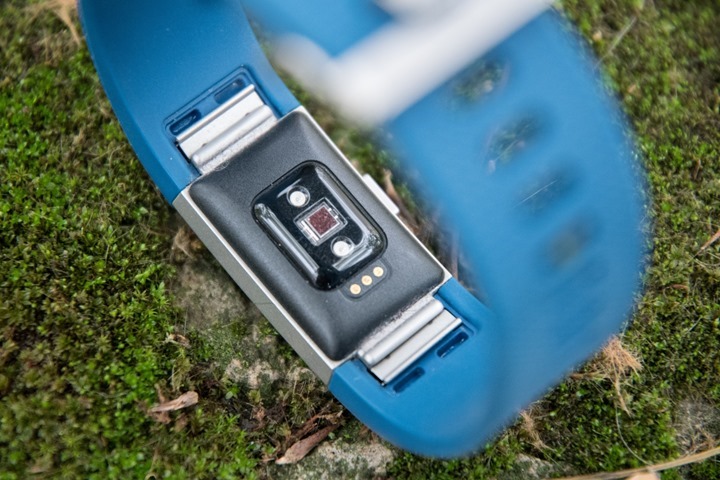
Anytime you add an optical heart rate (HR) sensor, you’re going to need to look at whether that optical HR sensor is accurate. In general, accuracy differs between the two most common uses of optical sensors: Workouts (exercise), and the remaining portion of your day – continual HR monitoring. For most devices, the continual HR monitoring that occurs throughout the day is the easy part. That’s because it doesn’t have much ‘noise’ to deal with in terms of running cadence or flexing of wrist muscles. Both of which are challenges that optical HR sensors have to overcome. In many cases, an optical HR sensor can become confused between the force of a foot strike and your heart rate, since at typical running cadences those two numbers are very similar. A hard foot strike effectively becomes your HR.
With the Fitbit Charge 2, I first looked at sedentary/continual HR monitoring. In this area, the unit generally does well. It’s within a few beats of a heart rate strap in most sitting/walking/typing/etc situations. As I sit here right now, the Fitbit Charge 2 is at 63bpm, while on the other wrist the Garmin FR35 is at 61bpm. Close enough given recording update rates/etc… I’ve been watching these values over the course of the last four weeks, and by and large they are virtually always within a few beats of each other, baring any slight differences in update rates (how quickly one might respond to a given stimulus).
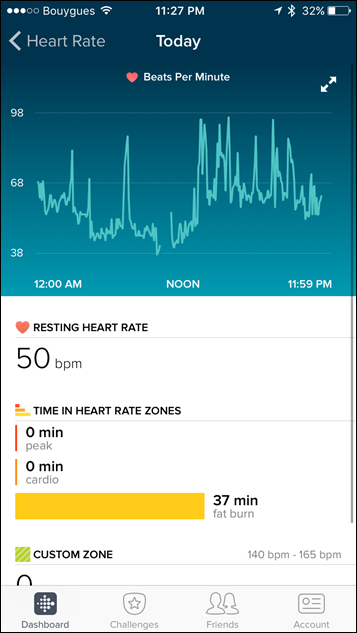
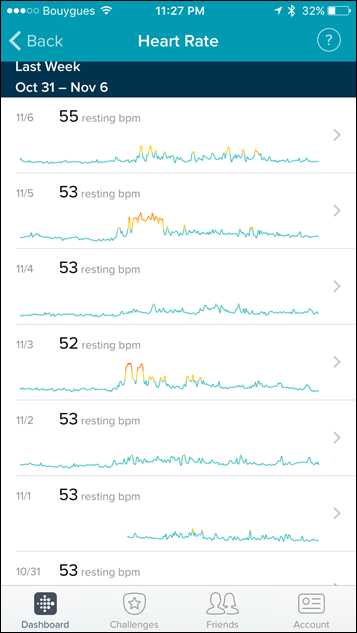
One slight annoyance of the Fitbit platform compared to others is their definition of resting HR, which isn’t the lowest HR recorded over the course of the day, but in theory the lowest HR while you’re awake. However, it seems to often misinterpret that. Meaning, I can sit still and watch TV and get a 40-41bpm resting HR within a few minutes. But it won’t show that on my trending data. Instead, it’s always in the 50’s.
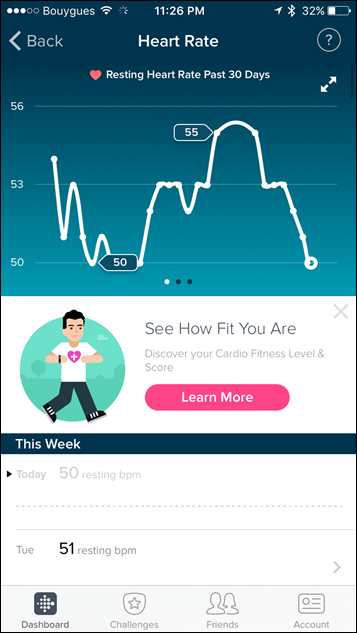
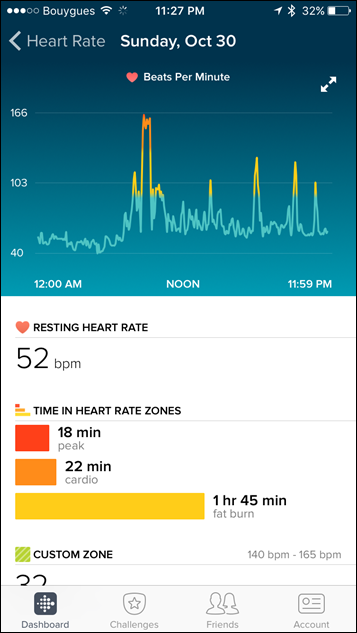
Fitbit’s own site contradicts itself here, where in one sentence it says it uses sleeping HR data, and then the very next sentence it says it doesn’t. Either way, it doesn’t much matter since it ignores the very data it records.

Next, workouts. Workouts are far tougher. For example, how quickly does the optical HR sensor respond to sharp changes in intensity (i.e. a sprint)? Or how well does it respond in cases where the wrist muscles might be taunt – such as while cycling or lifting weights. Again, areas optical HR sensors had struggles.
In my tests, I’m generally comparing against two or more additional units. Typically another optical HR sensor on a different wrist (never do tests with more than one optical HR sensor on the same wrist, as it’ll impact tests), and then a chest HR strap for comparison. Keep in mind that chest HR straps are just as susceptible to error as other device types, they are not infallible. To this day one of the most popular posts I have is around troubleshooting chest straps giving incorrect results, especially in cooler/dryer fall weather – primarily in the first ten minutes before you start sweating.
With that in mind, let’s dive into some results. I’m going to highlight a handful, but you can hit up the tables in this post to use the DCR Analyzer and dig more deeply into any of the comparative workouts. Oh, and one final caveat – unfortunately, Fitbit doesn’t correctly export HR data for activities that don’t have GPS with them. And by ‘correctly’, I mean ‘at all’. I noted this problem way back in my Fitbit Blaze In-Depth Review, but alas, nothing has been fixed. So that’s severely limited my analysis capability, since it makes it much less precise to compare HR accuracy.
On this first run, the route and intensity were both pretty flat, with only small variations.

You can see that right off the bat all three units disagreed. For whatever reason the traditional chest heart rate strap was crapping itself until I adjusted it at the 6 minute marker, then it was happy from there on out. Meanwhile the Fitbit Charge 2 spiked early on (inaccurate) while the Garmin FR35 stayed a bit more constant. In those first 5-6 minutes it’s hard to assign a specific winner, however my (pretty educated) guess knowing my HR intensities is that the FR35 was most correct. The Fitbit Charge 2 spike was incorrect, and it’s unlikely that I’d have been at that high of a HR early on. You see all the units converge as I went up a short climb.
Next, you’ll notice a short segment where I stopped briefly at a stoplight. You can see the HR recover between the different units. The Charge 2 actually does a better job of the recovery than the Garmin FR35 optical HR did, though not as correct as the quick recovery seen on the traditional chest strap.

And if I look at the last half of the run, things were very close between the three units. Which is what I tend to see on reasonably flat runs – most optical HR sensors get it right eventually.

You can dive into the above workout in more detail here.
Now as much as I’d like to dig into all my runs in more detail, as I noted earlier that’s actually really tough to do since the export on Fitbit’s site doesn’t export GPS-less HR data. For example, I can compare this HR graph during a trail run using screen clips – but it’s difficult to accurately see:


Still, in the above you can see distinct differences of opinion between the two units, somewhat common as I was starting out on a cold morning. The Garmin FR35 shows a more gradual increase in HR, while the Fitbit Charge 2 seems to flat-line out a bit early on. Both seem to roughly trace each other, but there are many nuances that aren’t clear.
Let’s instead look at a bike ride, since those Connected GPS rides do correctly export out HR data. Here’s a 90ish minute ride I did. Actually, it’s about 30 minutes of riding each way, with 30 minutes of photo/video shooting in the middle stationary. Either way, I’ll just let you ponder this graphic for a second.

So collectivity everyone sucked.
Or at least, the optical HR sensors did. This also isn’t surprising. It was a cool day riding, and since my wrists were exposed, that would have impacted the optical HR sensors in that area. Further, most optical HR sensors on the wrist have a tough time – and both the FR35 and Fitbit Charge 2 differ significantly here from the chest strap (connected to the Edge 820).
However, if I had to assign a ‘less sucky’ winner, it would be the FR35. The Fitbit Charge 2 is clearly furthest afield from the other two in most cases, especially the part where I’m standing around – which is kinda funny. But even on the first half there’s large gaps where it’s just lost. If you want to dig into these files more, you’ll find that mess here.
I wish I had a better way of analyzing more data. Other GPS based activities I did failed to record fully/properly, such as a 3hr ride, which is missing vast chunks of data. And then another run that was outdoors with GPS and thus also exportable HR also failed to set the GPS data, therefore I can’t compare HR data either. Still, the rough pattern I see is that for steady-state runs the optical HR sensor seems mostly fine. Cycling generally appears to suck. However for more varied intensity running you see slowness to respond in some areas while being a bit better than responsiveness that I saw on the first edition Fitbit Charge HR (non-2).
One last item – in theory I’m supposed to get a Cardio Fitness Score upon completing runs, which is essentially your VO2Max renamed. Fitbit says that may take some runs to appear, but in reality it still hasn’t shown up for me after any runs or rides (it sounds like it only works on runs). Perhaps my runs have been too hilly for the scoring algorithm to work.
GPS Accuracy:
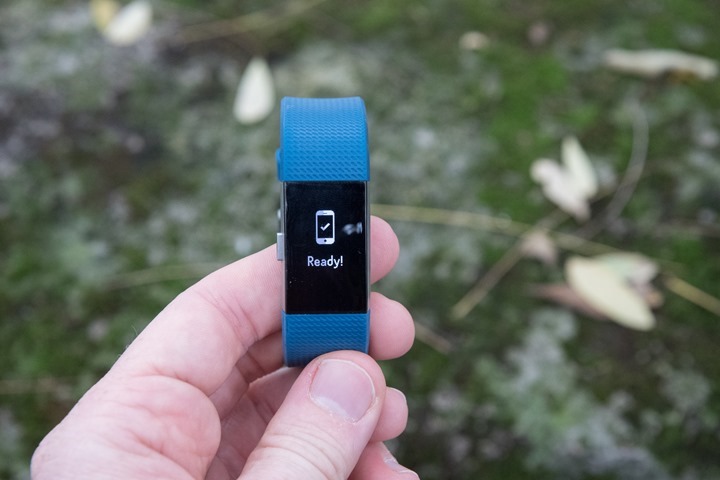
I’m only briefly going to touch on this, because in many ways it’s not real device GPS accuracy, but rather your phone’s GPS accuracy. And that will vary based on a crapton of factors, most notably your exact phone model.
With the Fitbit Charge 2, it uses what Fitbit calls ‘Connected GPS’, which means that it uses your phone’s GPS antenna. The Fitbit Charge 2 doesn’t have GPS itself. In order for Connected GPS to work, you need to be within range of your phone, and Bluetooth must be enabled on said phone. Further, the Fitbit app *must* be open and running in the background for this to work. And even with all those requirements, I find it sometimes finicky, especially if the Fitbit app hasn’t been opened extremely recently. It seemed best practice was to open the app up and then lock your phone’s screen (as you’d likely be putting it in an armband while running, or your back pocket while cycling.)
All that in mind, here’s a look at how it handled on my iPhone 6 in Connected GPS mode. Again, if you have a different phone you may get totally different results (better or worse). Here we go.
Workout #1: Bike ride
For the most part, the vast majority of GPS units succeed on bike rides. Mostly because the higher rate of speed actually makes things easier for most devices. Connected GPS on the Fitbit Charge 2 is no different. You can look at the entire activity file here. However, I’m going to pick out some ‘harder’ sections – things like bridges/overpasses/buildings/etc. Starting up, a case where one direction you go around a roundabout, while another you go under an overpass. All three units handled this perfectly.

Right around the corner from the above I make a sharp turn near some tall buildings. This is the only spot where you see a slight bit of variance on the Connected GPS of the Fitbit Charge 2, which is that purple line jutting across the road for no apparent reason. But seriously, this is no more than 10-15m in distance offset.

Throughout the rest of the route you see virtually no differences between the tracks, like below:

One thing I found interesting that I’ve never seen before is that the Fitbit app/device/etc appears to actually be smart enough to not plot points where it doesn’t have good GPS signal strength. Check out the below. The way it works is that there’s a stoplight I was at that put me below a large building/shopping below (the road passes under it). The FR35 and Edge 820 both plotted wonky-ass points in the vicinity. Whereas the Fitbit Charge 2 actually plotted no points here. It simply waited until it exited and then plotted a point.

One weird oddity though is that the Fitbit Charge 2 actually recorded two miles less than the other units. Those miles vanished somewhere.
Fitbit Charge 2: 13.55mi
Garmin FR35: 15.74mi
Garmin Edge 820: 15.38mi
Which makes no sense. It was never paused (no such function exists), and the tracks match identically. It’s like it just lost distance in space somewhere…magically. There’s widespread reports of this sort of thing happening in other reviews as well as Fitbit’s forums.
Workout #2: Running
In this case, this was a city run around Paris. The phone was on a Spibelt, which means it wouldn’t have had the best GPS signal, but that’s the reality of having a wearable with no GPS. Sometimes the phone has to go in a non-ideal place. We all know that for the most part GPS is better worn on the upper-arm, but what about on the waist?
Throughout the vast majority of the run, the GPS track is actually pretty good.

There’s a case around those fountains in the park (purple) below where it seems offset a few meters, but again, no real big deal here.

The one ‘yikes’ moment is passing through/into the Louvre, where both it and the Garmin FR35 completely crapped the bed. This was a straight shot into the building and back out the other side, but both units went completely wonky. However, in a rare display of GPS prowess, the Suunto Spartan Ultra actually correctly plotted much of this portion. Assuming you ignore that it was offset 50m into the building from the street. But what’s half a football field between friends?

Still, I wouldn’t let the above dissuade you one way or another. It’s an extremely difficult passage through what is a tunnel in one of the world’s largest buildings. GPS does wonky stuff in tunnels – and even more so in tunnels in the middle of a city. What is key here is that the units very quickly recovered upon exiting the tunnel and nearing the Pyramid at the Louvre. After which, they were fine. Oh – if you’re curious, you can dive into these GPS tracks here. You’ll note on this run the distances were 7.13mi for the Fitbit Charge 2, and 7.03mi for the FR35. Basically, within stated accuracy rates of +/- 2%.
Next, what about non-connected accuracy of distance? Well for some runs I did just that. I left my phone behind and let it determine distance based on the accelerometer. You won’t get a GPS track, but you will get distance. In many ways, that’s actually not to shabby. Just to keep things simple – here’s the distances reported by the Fitbit Charge 2, and that of other GPS devices on the same activity:
Workout A Outdoor Mountain Run – Nov 3rd
Fitbit Charge 2: 7.18mi
Garmin FR35 GPS: 6.23mi
Workout B Outdoor Wooded Trail Run – Oct 30th
Fitbit Charge 2: 4.63mi
Garmin FR35 GPS: 4.03mi
Workout C – Treadmill – Nov 10th
Fitbit Charge 2: 3.32mi
Garmin FR35: 2.95
On that final treadmill activity, the actual distance isn’t known. While I had gotten on the treadmill, I didn’t realize that it started with some amount of distance already on it. I noticed around the 1 mile marker that it was a bunch ahead of that, but alas, I have no idea if that was 1/3rd of a mile or 2/3rds of a mile – which in this case makes all the difference.
Smartphone App:
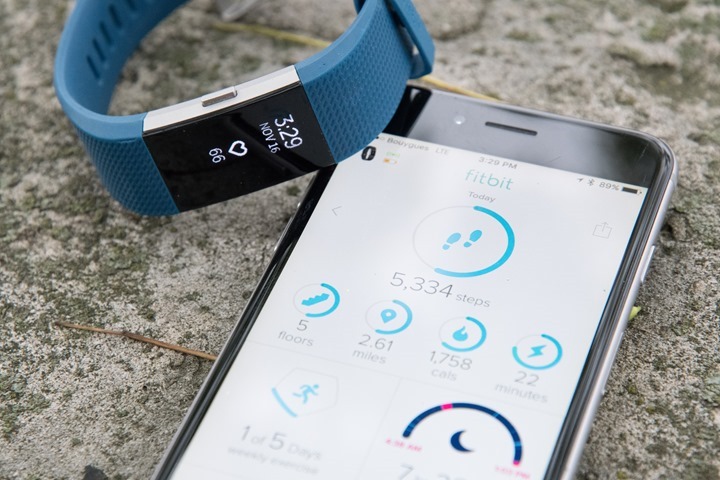
Over the last few months Fitbit has refreshed their mobile apps (or at least, their iOS app). Nothing major, but just cleaned up the look of things a bit. The mobile app is ultimately the epicenter of where you’ll check various Fitbit stats, be it your own stats, or friends that you’re taunting through your stepilicious activity.
The main page on the app covers all the stats for the day, and in the case of sleep – the previous night. It also covers any exercise you’ve completed with the tracker. You can tap on any given metric to see more detail about that piece. For example, tap the steps icon and you get details about the week in steps, and tap a given day and you’ll get a timeline of that day. Just like below.
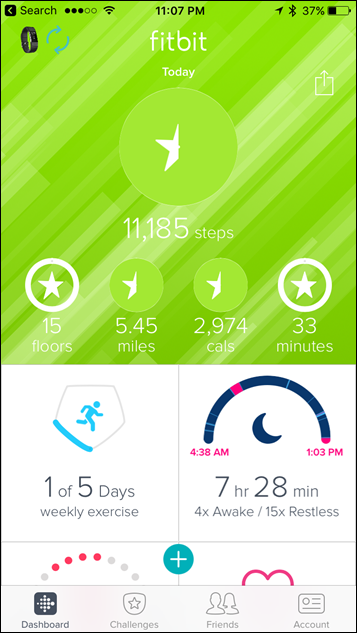
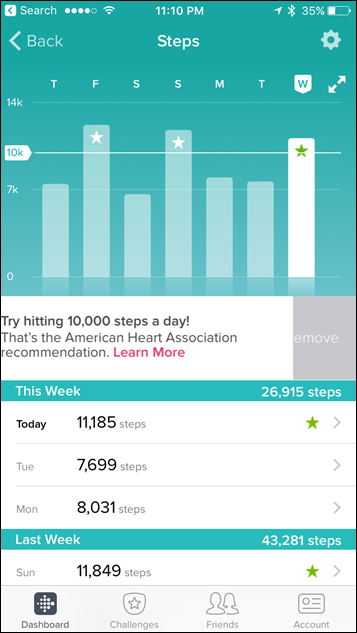
The same is true of sleep. As obvious, my sleep schedule has been all hosed up the last few days after returning from the US. The baby has decided to remain on some alternate time zone.
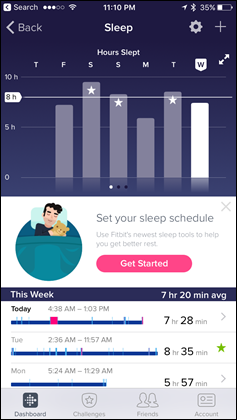
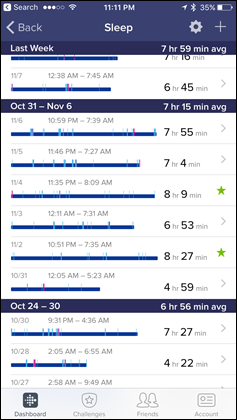
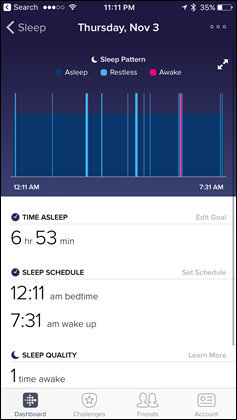
One of the big benefits of the Fitbit ecosystem is how many people use it. In my case I only have a whopping 4 friends, one of which is actually using their Fitbit still. Still, I can see how I rank up against her. I can also find other friends and check out my current friends’ badges.
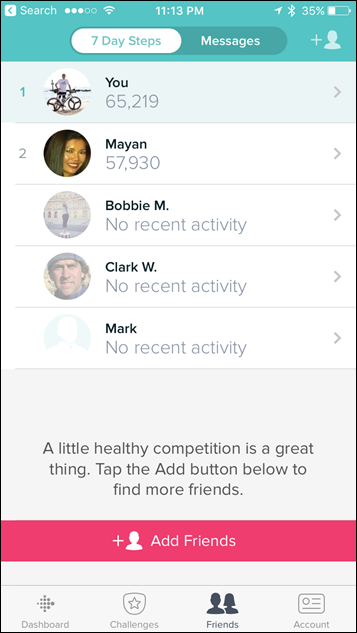
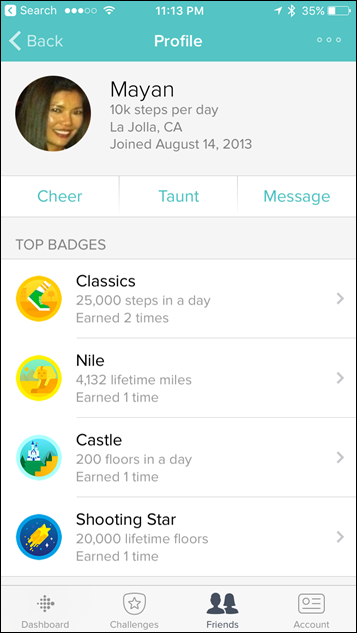
The app allows you to sign-up for challenges as well. These are designed to sucker you into walking more than you might otherwise.
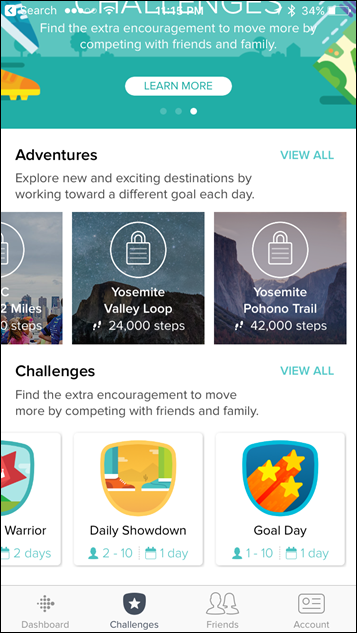
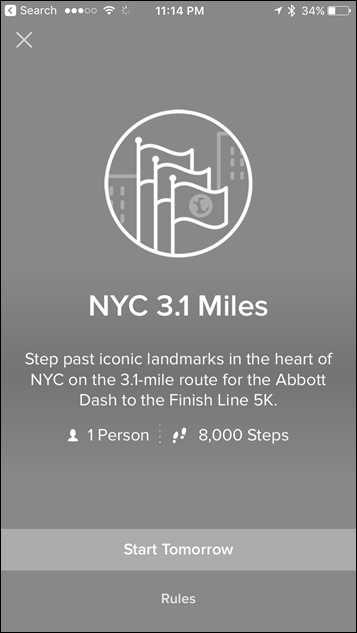
Beyond that, most of the remaining pages I’ve already showed within the post. These are primarily settings related, such as configuring the display on the unit and how it might greet you.
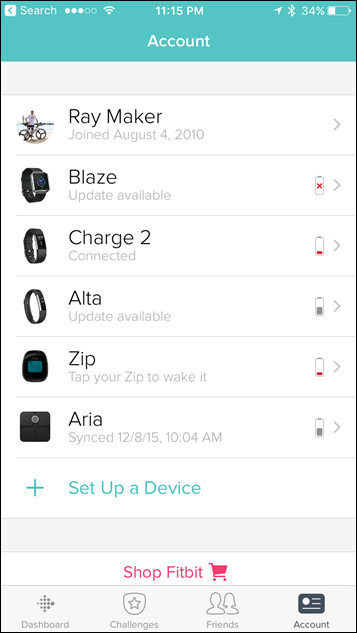
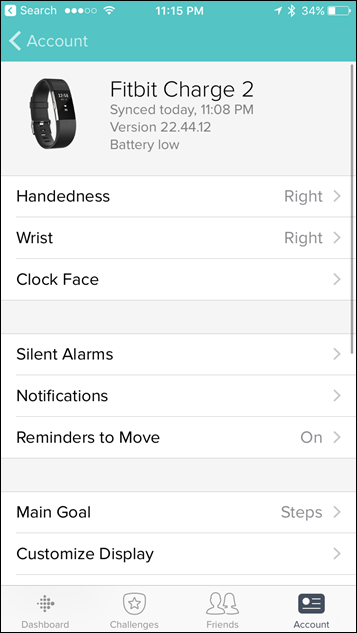
Additionally, a handful of other pages are within the app related to other devices or services. For example, a water bottle from Thermos that integrates with the Fitbit platform will show you how much you drank. And then of course the Fitbit WiFi scale as well.
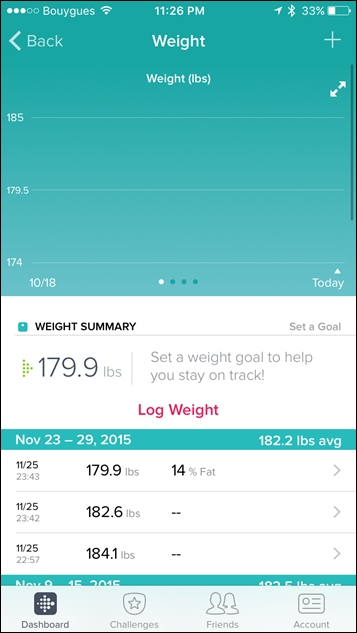
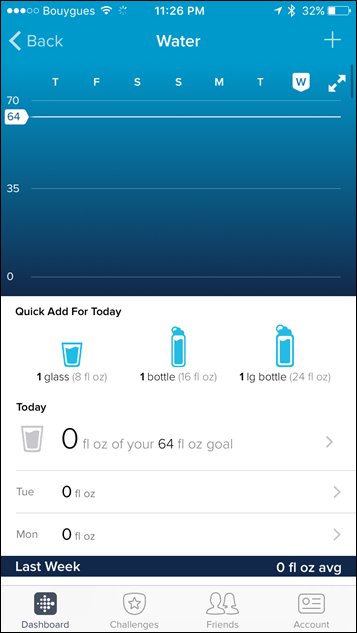
Ultimately the app works fairly well. It covers pretty much all the basics you might want. It doesn’t however go into much of the deeper analytic and insight pieces that some activity trackers are doing now, where they analyze your patterns and offer suggestions in areas such as sleep. But for the most part Fitbit is overall one of the leaders when it comes to their activity tracking smartphone app.
Product Comparisons:
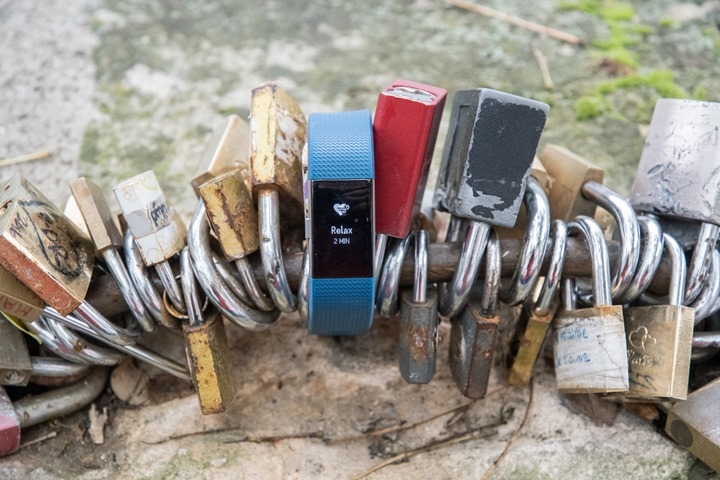
You’ll find the Fitbit Charge 2 within the product comparison tool for activity trackers. It’s not currently in the GPS-based product comparison portion, since it lacks a GPS chipset. If there’s interest, I can look at adding it into that database nonetheless. In any case, you can mix and match it against various activity trackers in the database. For the purposes of comparison below, I’ve compared it against the Garmin Vivosmart, Polar A360 and the original Fitbit Charge HR. But again, you can create your own comparison charts here.
Copyright DC Rainmaker – Updated February 4th, 2017 @ 7:10 amNew Window
Price$149$149$149$199
Body PlacementWristWristWristWrist
Data Transfer TypeBluetooth SmartBluetooth SmartBluetooth Smart, USBUSB, Bluetooth Smart
Bluetooth to PhoneYesYesYesYes
Has GPS built-inNo (can use phone’s GPS though)NoNoNo
WaterproofingSplash only1ATM (~10m)50m30m
Battery LifeUp to 5 daysUp to 5 daysUp to 5 daysUp to 2 weeks
Battery TypeUSB RechargeableUSB RechargeableUSB RechargeableUSB Rechargeable
Changeable Bands/StrapsYesNoNoYes
Phone Music ControlNoNoYes
Displays timeYesYesYesYes
Has time alarmsYesYesYesYes
Has smart sleep alarmsNoNoNoNo
Smartphone NotificationsYes (Text/Phone/Calendar only)Call notifications onlyYesYes
Workout guidance/coachingInterval workoutsNoNoYes
Step CounterYesYesYesYes
Stairs ClimbedYEsYesYesNo
Distance WalkedYEsYesYEsYes
Calories BurnedYEsYesYesYes
Sleep MetricsYesYesYEsYes
24×7 HR MetricsYesYesYesNo
Skin TemperatureNoNoNoNo
Heart RateYesYesYes (Internal)Yes
Optical Heart RateYesYesYesYes
Can re-broadcast Heart Rate dataNoNoYesOnly to certain Polar platforms
Skin PerspirationNoNoNoNo
Cycling SensorsNoNoNoNo
Action Camera ControlNoNoYesNo
Web ApplicationYesYesYesYes
PC ApplicationYesYesYesYes
Mac ApplicationYesYesYEsYes
Phone AppsiOS/Android/Windows PhoneiOS/Android/Windows PhoneiOS/Android/Windows PhoneiPhone/Android
Ability to export/sync settings from computer/phoneYesYesYesYes
3rd parties can access data via APIYEsYesYesSorta
Ability to export your data out of platformYEsYesYesYes
Amazon LinkLinkLinkLinkLink
Clever Training – Save a bunch with Clever Training VIP programLinkLinkLinkLink
Clever Training – Save a bunch with Clever Training VIP programLink
Review LinkLinkLinkLinkLink
And don’t forget, you can create your own comparison charts here within the product comparison tool.
Summary:
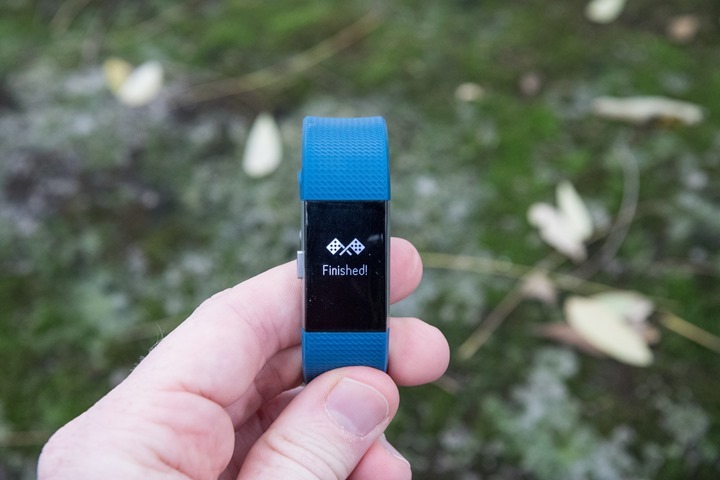
As with almost all Fitbit products, they tend to be a popular and well rounded offering. And the Charge 2 is mostly in that same vein. The unit includes new sport modes that help you to get better data about your specific activity. Plus, the separable bands are nice should you want to mix things up. And 24×7 HR accuracy continues to be generally good.
On the flip side, workout HR accuracy is highly mixed, especially in cycling. Further, new features like the breathing/relaxation pieces seem more like placebos, at least in terms of what the display is showing. Next, the Connected GPS functionality seems to be more troublesome than it’s been in the past, often not connecting properly and then dropping the connection without reason, along with missing miles. And lastly, the unit somehow still lacks proper waterproofing.
When companies get as big in market share as Fitbit, you start to see the slowdown in innovation, while competitors continue to push forward and innovate faster. We’ve seen that here with what are largely modest updates to the behemoth that is Fitbit. They got to that position for good reason of course – their platform is largely clean and easy to use, as are the wearables themselves. But when you look at the nearly 1-year old Vivosmart HR from Garmin, it’s more capable in virtually every way than the Fitbit Charge 2 (at the same price normally, though $30 cheaper right now on sale).
So my general advice on activity trackers is that if you find the features meet your requirements, select a device that matches your friends. If your friends/family are all on Fitbit, then it likely makes sense to match that – so you can benefit from the various social encouragement features. Inversely, if you already have a Garmin bike computer, then it makes sense to stay on Garmin so you get a single cohesive picture.
But if you don’t have any other techno-strings attached, you’re effectively a free agent and there’s plenty of great options out there. The world’s your oyster!
Wanna save 10%? Or found this review useful? Read on!

Hopefully you found this review useful. At the end of the day, I’m an athlete just like you looking for the most detail possible on a new purchase – so my review is written from the standpoint of how I used the device. The reviews generally take a lot of hours to put together, so it’s a fair bit of work (and labor of love). As you probably noticed by looking below, I also take time to answer all the questions posted in the comments – and there’s quite a bit of detail in there as well.
I’ve partnered with Clever Training to offer all DC Rainmaker readers an exclusive 10% discount across the board on all products (except clearance items). You can pickup the Fitbit Charge 2 (or any other Fitbit Charge 2 bands) from Clever Training. Then receive 10% off of everything in your cart by adding code DCR10BTF at checkout. By doing so, you not only support the site (and all the work I do here) – but you also get a sweet discount. And, since this item is more than $75, you get free US shipping as well.
Fitbit Charge 2 (select drop-down for size/colors)
Fitbit Aria Scale (compatible with Fitbit Charge 2, see my WiFi Scale roundup here)
Additionally, you can also use Amazon to purchase the unit (all colors shown after clicking through to the left) or accessories (though, no discount on Amazon). Or, anything else you pickup on Amazon helps support the site as well (socks, laundry detergent, cowbells). If you’re outside the US, I’ve got links to all of the major individual country Amazon stores on the sidebar towards the top. Though, Clever Training also ships there too and you get the 10% discount.
Thanks for reading!
